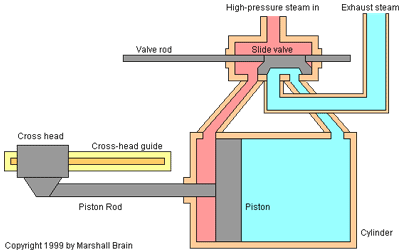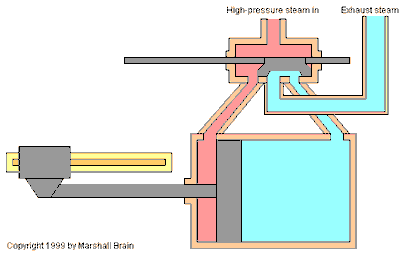|
The following
diagram shows the major components of a piston steam engine.
This sort of engine would be typical in a steam locomotive.

The engine
shown is a double-acting steam engine because the valve allows
high-pressure steam to act alternately on both faces of the
piston. The following animation shows the engine in action:

You can
see that the slide valve is in charge of letting the high-pressure
steam into either side of the cylinder. The control rod for
the valve is usually hooked into a linkage attached to the
cross-head, so that the motion of the cross-head slides the
valve as well. (On a steam locomotive, this linkage also allows
the engineer to put the train into reverse.)
You can
see in this diagram that the exhaust steam simply vents out
into the air. This fact explains two things about steam locomotives:
- It
explains why they have to take on water at the station --
the water is constantly being lost through the steam exhaust.
- It
explains where the "choo-choo" sound comes from.
When the valve opens the cylinder to release its steam exhaust,
the steam escapes under a great deal of pressure and makes
a "choo!" sound as it exits. When the train is
first starting, the piston is moving very slowly, but then
as the train starts rolling the piston gains speed. The
effect of this is the "Choo..... choo.... choo... choo
choo-choo-choo" that we hear when it starts moving.
On a steam
locomotive, the cross-head normally links to a drive rod,
and from there to coupling rods that drive the locomotive's
wheels. The cross-head is connected to a drive rod that connects
to one of three drive wheels for the train. The three wheels
are connected via coupling rods so they turn in unison. |








